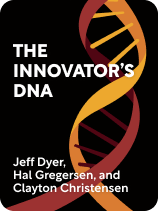

This article is an excerpt from the Shortform book guide to "The Innovator’s DNA" by Jeff Dyer, Hal Gregersen, and Clayton Christensen. Shortform has the world's best summaries and analyses of books you should be reading.
Like this article? Sign up for a free trial here.
What do innovative organizations have in common? How can you set your company up for breakthroughs?
The authors of The Innovator’s DNA identify five behaviors and skills shared by the top innovators. Then, they explain how to drive meaningful change by embedding these behaviors and skills into your organization. They address team makeup and structure, workflows, and mindset.
Keep reading to learn what innovative organizations have in common, and see how you can count your company among them by doing what they do.
Innovative Organizations
The authors describe five behaviors and skills—what they call Discovery Skills—that are most likely to generate creative ideas. These are associative thinking, questioning, observing, idea networking, and experimenting. Let’s look at how you can apply those skills to build and sustain innovative organizations and teams.
The leaders and founders of innovative companies shouldn’t expect their employees to innovate on their own but instead help them innovate by embedding innovation into every level of their organizations—through team structures, workflows, and company mindset. Developing innovative capabilities at each level of your business is important because innovation leads to growth opportunities.
(Shortform note: Some business experts agree that investing time and thoughtful effort into your organization’s teams is important and argue further that an organization’s collective skills, abilities, and expertise—the human elements behind the scenes—are even more important to long-term success than more publicly valued aspects of a business, like its innovation reputation or technology. Collective organizational skills and capabilities are more stable, unique, and harder to imitate than other business aspects (like access to the financial markets), which provides investors with confidence in future earnings.)
Team Structures
Optimize innovation in your organization by building and structuring your teams so that members have diverse perspectives and complementary Discovery Skills. To do this, you must hire the right people—look for potential hires with a track record of strong Discovery Skills and a passion for making big changes in the world. Prioritize candidates with expertise in different disciplines. Diverse perspectives from fields like sociology, psychology, engineering, and science foster associative thinking within an organization and contribute valuable insights into new products, services, and processes.
Once you have the right people, structure teams so that members’ Discovery Skills balance and complement each other. Find out who has strengths in which skills and make sure each Discovery Skill is represented in equal measure within a team. Paying attention to the balance of Discovery Skills in a team can make the difference between a consistently innovative team and one that struggles to think creatively and bring viable ideas to market.
| Collective Capabilities Are Key to Organizational Success Thoughtfully structuring your teams based on members’ diverse strengths and perspectives is an approach supported by the same business experts who advocate for investing in your organization’s collective abilities. In addition to Discovery Skills and creativity, they outline other collective capabilities that well-managed companies typically exhibit within their teams, including the following: Shared brand image: This ensures that team members have a cohesive understanding of who and what the organization is, which could help individuals feel collectively aligned with the company. Partnership: Encourage and facilitate different departments or teams working with one another to maximize efficiency and resources. Integration: Embed high-quality leadership throughout the organization to foster alignment and coherence among individuals within teams, between teams, and within the larger organization. |
Workflows
To implement workflows that encourage innovation, you must first model innovative behaviors to your team by frequently and visibly making associations, questioning, observing, networking, and experimenting. Then, develop processes that require or at least make it easy for people to use their skills. The authors outline various ideas for ways to systematize the use of Discovery Skills in your company:
Institute the 5 Whys questioning system. Ask “why” about a problem or situation at least five times to get to the root cause. In other words, when you ask the initial question, ask why about the answer, then ask why about that answer, and so forth. This method, developed by a former Toyota engineer, is widely used by many successful innovative companies.
(Shortform note: The 5 Whys technique was first developed by Sakichi Toyoda and used in the Toyota Motor Corporation’s manufacturing methodologies. It is a critical part of problem-solving training in the Toyota Production System, and it’s used to identify the root cause of problems.)
Develop formal and informal networking opportunities to facilitate knowledge-sharing inside and outside the organization. For example, the authors suggest you encourage employees to eat lunch together or create a company competition for the most innovative idea and fund the winner.
(Shortform note: With hybrid and remote work arrangements increasing for many companies, the opportunities for informal networking and knowledge sharing (like eating lunch together) are becoming less viable. One idea for virtual networking opportunities is to recreate the experience of an office setting by encouraging your teams to work alongside one another virtually. To do this, open video calls during work sessions so coworkers can ask questions and trade ideas easily in real-time, as they would if they were working in person. As the authors recommend, idea sharing through company innovation competitions will translate well to virtual settings.)
Institutionalize experimentation through product testing, pilot projects, and “beta” product releases (which allow the public to try out new offerings and gather valuable feedback in the process).
(Shortform note: Feedback is valuable to you if the information is clear and insightful. To ensure you receive valuable feedback, some business experts recommend you consider gathering feedback from customers who have never used a product or service like the one you’re testing because they often will interact with the product or service in unanticipated ways. Additionally, you can collect feedback from clients by sending them a feedback form via email. Make the form easy for clients to fill out to help them provide comprehensive accounts of their experience.)
Company Mindset
Innovative leaders must infuse their organizations and teams with a commitment to innovation. Company mindsets are most effective when they’re shared among everyone and believed in. The authors outline three core tenets you can adopt to support all of your employees in having an innovative mindset:
- Prioritize funding for disruptive innovation. Spend more money on research and development. Focus on new and not just improved products and services.
- Promote the belief that innovation is everyone’s job. Train them on the five Discovery Skills, and let them fail and learn.
- Embrace risk, and expect mistakes.

———End of Preview———
Like what you just read? Read the rest of the world's best book summary and analysis of Jeff Dyer, Hal Gregersen, and Clayton Christensen's "The Innovator’s DNA" at Shortform.
Here's what you'll find in our full The Innovator’s DNA summary:
- The five key skills that are shared by the world's innovation leaders
- Why innovation in business is so important
- How to sustain innovative organizations and teams long term






